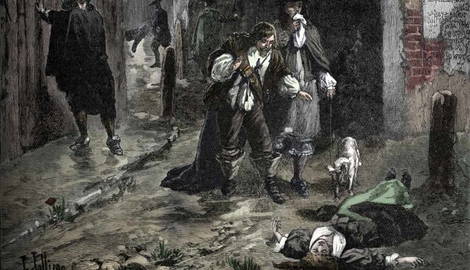
The plague traveled through Europe at an alarming rate during the seventeenth century. In its wake, it left a trail of devastation from which no one was immune, apart from a little town in what is now Southern Germany. But how was this possible? How did the small town of Oberammergau earn its immunity? And how did this immunity lead to a 10-year tradition of staging Passion Plays which has continued with only a few interruptions for the past 30 years?
The Plague Arrives in Oberammergau & Europe

Oberammergau is a small village in Bavaria, the largest land state in Germany. Located in the southeast of the country, the village is famous not only for its dealings with the plague, but also for its wood carvings.
The town is set in a breath-taking location among the Ammergau Alps which makes it a popular tourist destination for hikers. While the town has always been beautiful and peaceful, it was not originally spared from the devastation caused by the plague in the seventeenth century.
The plague had existed in Europe since the 1300s when it had first devastated the continent. From that point until the seventeenth century, it flared up in waves and remained a great source of fear and unease for many.
It is now believed that the disease began its long life in China and Inner Asia. It then spread to Crimea and then to the Mediterranean port towns via infected ships. From there, it began its deadly journey into mainland Europe and Africa. It arrived in Sicily in 1347 and then made its way to North Africa, Italy, Spain and France a year later. By 1349, it was in Austria, Hungary, Switzerland, Germany and the Low Countries.

The plague arrived in England in the August of 1348 when it was brought by an infected ship from Calais. The pandemic in Britain began in Melcombe Regis, Dorset and spread through the country at an alarming rate. It hit the capital, London, by February where people suffered badly until May. East Anglia and Yorkshire were hit the next summer and by 1350, the plague had reached as far as Scotland, Scandinavia, and the Baltic.
While we have known for a long time that the Plague recurred throughout Europe, we now know that it was reintroduced via trade routes that came in waves from Central Asia. The number of deaths per wave and per place varied.
The plague first arrived in Oberammergau, according to legend, when a villager who had been away returned infected with the disease. According to the records, one in four people were thought to have passed away in the village due to the disease.
Response in Oberammergau

There were a large number of responses to the plague across Europe and the wider world. Some included early public health measures like quarantine and localised lockdowns. Some also, as those in Oberammergau did, turned to religion and prayer in an attempt to find salvation and answers.
The people of Oberammergau, like many affected by the plague, could see no end to their suffering and sought out God. They prayed to God and asked him for help, promising that if he helped, they would perform the Passion Play (which tells of Jesus’ life, death, and resurrection) every ten years forever.
While the plague continued to devastate the rest of Europe, the prayers had seemingly worked. The town recorded no further deaths after 1633, when they had made their prayers. There are many reasons why the records may have stopped, however.
They may have stopped because the villagers’ prayers had worked, and no one else in the village died. They may have been deliberately stopped in order to make it appear as though the prayers had worked. However, because no one recorded the reasons, historians today do not know the motivation.
Nevertheless, since 1633, when the records stopped, the town has continued to put on the passion play every ten years. The tradition has remained in place for the last 300 years with only a few interruptions, including a world war and COVID-19.
The Passion Play

The first ever Passion Play took place in 1634. The performance was staged in the cemetery next to the parish church above the graves of plague victims. It wasn’t until 1830 that the play was relocated to the spot where it is still performed to this day.
The Passion Play has remained very much the same for the last 300 years, with rules in place that have stood the test of time. The entire experience lasts eight hours, with a three-hour intermission that involves dinner.
In order to perform in the play, one must have been born in the town, married to a local for ten years, or have lived there for 20 years; no exceptions have ever been made. The villagers make all the costumes, and actors are not allowed to wear wigs, so many participants take to growing their hair during the year prior to the play.
While 2,000 villages take part, there are only 124 speaking roles to audition for. Today, you are able to go and watch the play; however, please note the entire play is in German! The most recent play was meant to occur in 2020 but was postponed until 2022 because of the Coronavirus pandemic.

In conclusion, it appears that with the plague outbreak in the 1600s, Oberammergau had the same experiences as most of Germany. Fear and devastation spread. Public health measures may have been attempted and scapegoats targeted. However, what makes Oberammergau stand out in history is their perceived salvation.
Is it a simple coincidence that they were saved after praying to God and making him a promise to continue the Passion Play every ten years? Can we trust the records that simply just stop after the promise was made in 1633? Did they stop because people stopped dying, or is there another reason? These are questions to which, much to everyone’s annoyance, we’ll probably never get any definite answers.










